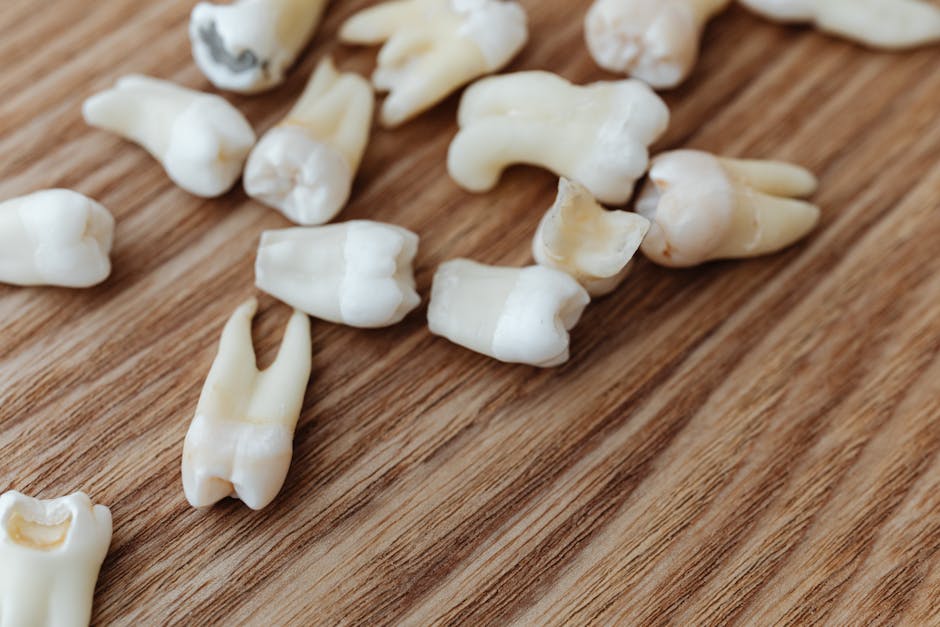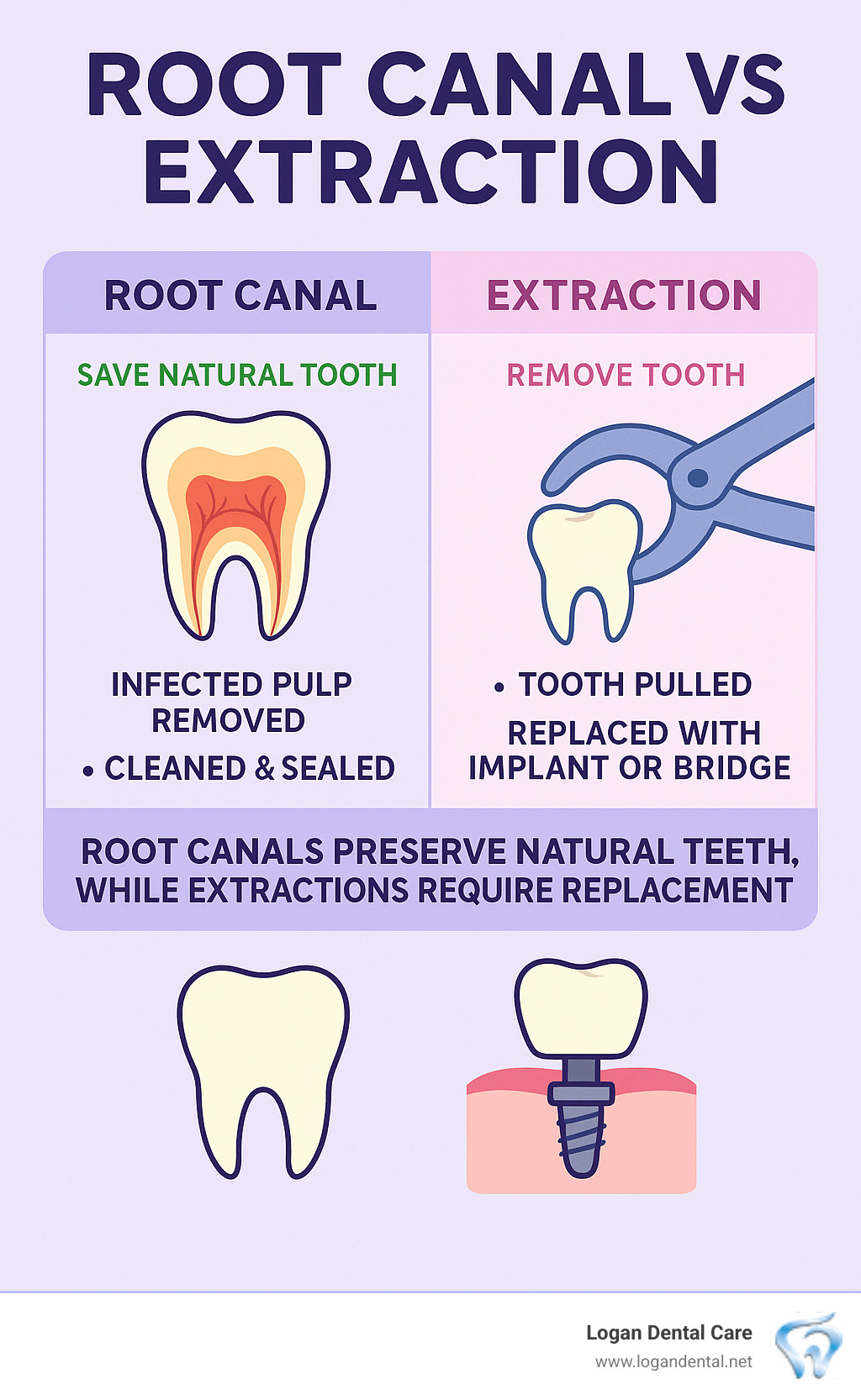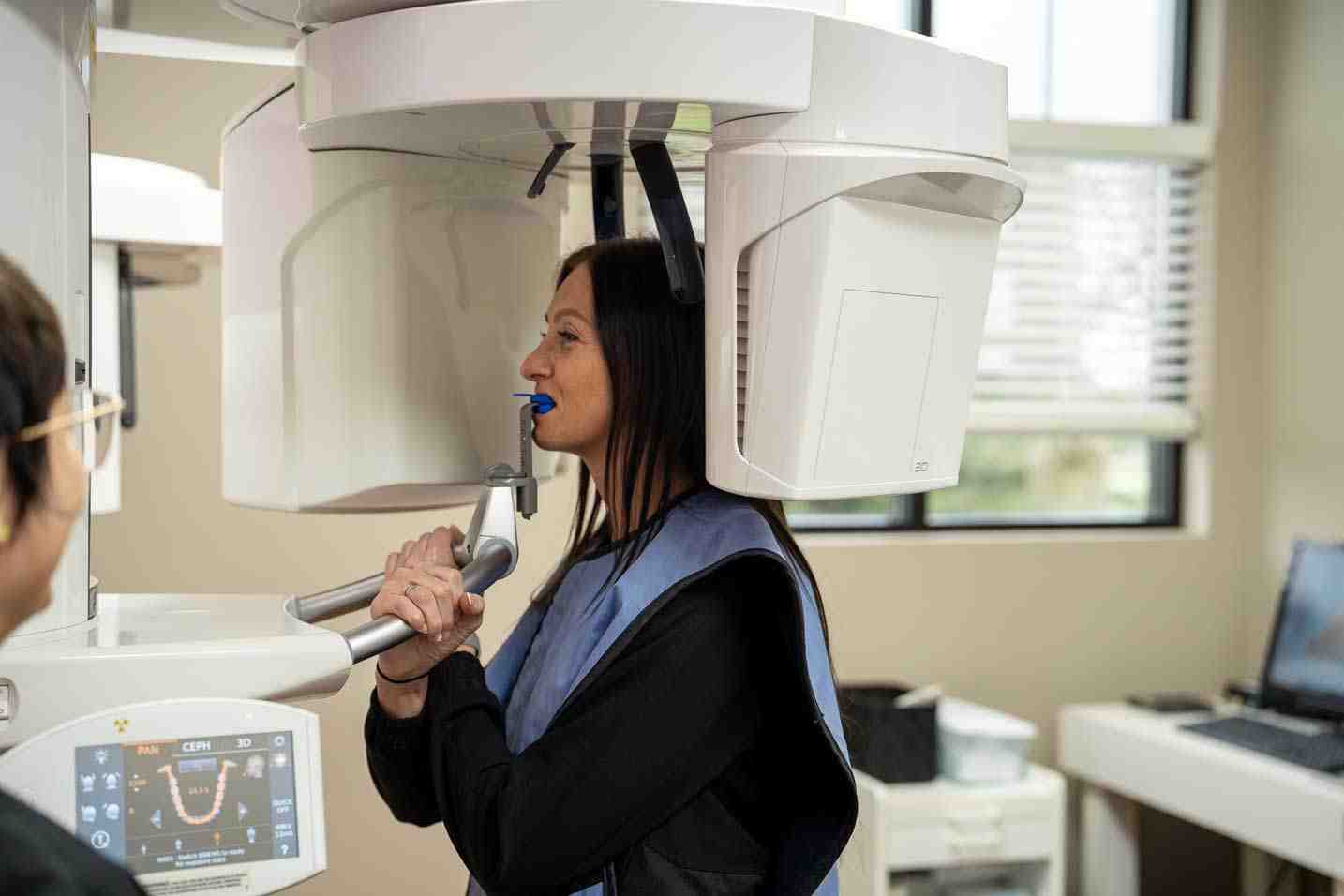Battle of the Teeth – Choosing Between Root Canal and Extraction

Facing a Dental Dilemma: An Introduction
When facing severe tooth pain or infection, root canal vs extraction becomes a critical decision that can impact your oral health for years to come. Here's what you need to know:
Root Canal:
- Goal: Save your natural tooth
- Procedure: Remove infected pulp, clean, and seal the tooth
- Cost: $700-$1,500 (plus crown ~$1,300)
- Recovery: Few days with mild discomfort
- Success Rate: 80% long-term success
Extraction:
- Goal: Remove the problematic tooth entirely
- Procedure: Pull tooth from socket
- Cost: $75-$300 (plus replacement $4,000-$10,500)
- Recovery: 1-2 weeks with more significant pain
- Follow-up: Usually requires tooth replacement
Nothing looks, feels, or functions like your natural tooth. That's why dental professionals generally recommend saving your tooth with a root canal whenever possible.
The reality is simple: Root canals preserve your natural tooth structure, while extractions require expensive replacements like implants or bridges. Research shows that patients who choose root canal treatment are six times more likely to describe it as painless compared to those who opt for extraction.
When you're juggling work and family responsibilities, the last thing you want is multiple dental appointments and extended recovery time. Understanding these two options helps you make an informed decision that fits your lifestyle and budget.

A Head-to-Head Comparison: Root Canal vs. Extraction
When you're sitting in the dental chair with a throbbing tooth, the choice between root canal vs extraction can feel overwhelming. Let's break down what each option really means for your mouth, your wallet, and your future.
| Factor | Root Canal | Extraction |
|---|---|---|
| Goal | Save and preserve natural tooth | Remove problematic tooth completely |
| Procedure Time | 60-90 minutes per visit (1-3 visits) | 5-45 minutes (typically 1 visit) |
| Initial Cost | $700-$1,500 + crown ($1,300) | $75-$300 |
| Long-term Cost | Often less expensive overall | Requires replacement ($4,000-$10,500) |
| Recovery | Few days, mild discomfort | 1-2 weeks, more significant pain |
| Success Rate | 80% long-term success | Nearly 100% for removal |
| Natural Tooth | Preserved | Lost permanently |
Here's the thing about natural tooth preservation – your original teeth are like a perfectly choreographed dance team. Each tooth knows its role, and they work together to help you chew, speak, and smile confidently. When we can save your tooth with a root canal, we're keeping that natural harmony intact.
Think of it this way: your teeth have been with you through countless meals, conversations, and smiles. They've adapted to your unique bite and speech patterns. That's why at Logan Dental Care, we always explore every option to save your natural tooth first.
But sometimes, despite our best efforts, a tooth is too damaged to save. When extraction becomes necessary, we don't just leave you hanging. Modern tooth replacement options like dental implants or crowns and bridges can restore both function and appearance beautifully.
The key difference? Root canals preserve what nature gave you, while extractions require us to rebuild what was lost. Both can be excellent solutions – it just depends on what your specific situation calls for.
The Procedures Explained: What Happens During Treatment?

Root Canal Treatment:
Don't let the scary stories fool you – modern root canal treatment is nothing like what your grandfather might have experienced. Here's what actually happens when we save your tooth:
First, we take X-rays to see exactly what we're dealing with. Then comes the local anesthesia – you'll feel a little pinch, and then... nothing. We make a tiny opening in your tooth's crown, kind of like opening a very small door.
The infected pulp and nerve tissue come out next. We clean those root canals thoroughly, making sure every bit of bacteria is gone. It's meticulous work, but that's what ensures your tooth stays healthy for years to come.
Finally, we fill the cleaned canals with gutta-percha, a biocompatible material that seals everything up tight. Most of the time, you'll need a crown afterward to protect your newly treated tooth.
The whole process usually takes one to three appointments, with each visit lasting about 60 to 90 minutes. Many of our patients are surprised by how comfortable the entire experience is.

Tooth Extraction:
Tooth extractions are straightforward procedures, but they come in two varieties:
Simple extractions handle teeth that are visible above your gum line. We numb the area, gently loosen the tooth with special tools, and remove it with forceps. These typically take 5 to 20 minutes.
Surgical extractions are needed when teeth are broken, impacted, or hiding below the gum line. We might need to make a small incision or remove a bit of bone to access the tooth. These procedures take 20 to 45 minutes.
Both types are designed to be as comfortable as possible. We use modern anesthesia techniques to ensure you don't feel pain during the procedure. If you're curious about the technical details, the American Association of Endodontists has more info about what a root canal is that you might find helpful.
Pain and Recovery: Debunking Myths and Setting Expectations
Let's tackle the elephant in the room – pain. If you're like most people, you've probably heard horror stories about root canals that would make your hair stand on end. Here's the truth: those stories are mostly outdated myths.
During Treatment:With modern dental techniques and anesthesia, both procedures should be comfortable. Local anesthesia effectively numbs the area, so you shouldn't feel pain during either treatment. You might feel some pressure or vibration, but that's about it.
After Treatment:This is where root canal vs extraction shows a clear difference. Root canal recovery is typically much easier than extraction recovery.
Root canal patients usually experience mild discomfort for 2 to 3 days. Over-the-counter pain relievers like ibuprofen or acetaminophen are usually enough. Most people return to normal activities the next day, though we recommend avoiding hard foods until your permanent restoration is placed.
Extraction patients face more significant pain and swelling for 1 to 2 weeks. You might need prescription pain medication, and we recommend taking it easy for at least 24 hours. There's also a higher risk of complications like dry socket.
The AAE research on pain perception backs this up – patients who choose root canal treatment are six times more likely to describe it as painless compared to those who opt for extraction.
Recovery Guidelines:
For root canal recovery: Take any prescribed antibiotics, use over-the-counter pain relievers as directed, and stick to soft foods for the first few days. Avoid chewing on the treated tooth until your permanent restoration is placed, and don't ignore persistent pain or swelling.
For extraction recovery: Bite on gauze for 30 to 45 minutes after surgery, apply ice packs to reduce swelling, and eat soft, cool foods. Avoid straws and smoking (they increase dry socket risk), and don't rinse vigorously for 24 hours.
Our tooth extraction recovery tips provide comprehensive guidance if you need more detailed healing instructions.
The Financial Factor: Comparing Initial and Long-Term Costs

Money talks, and when it comes to root canal vs extraction, the conversation gets interesting. At first glance, extraction looks like the budget-friendly option. But here's where math becomes your friend – or your enemy.
Root canal treatment costs $700 to $1,500, plus a crown for about $1,300. Your total initial investment runs $2,000 to $2,800. It sounds like a lot, but remember – you're done. One tooth, one treatment, one bill.
Extraction seems cheaper upfront at $75 to $300 for simple extractions or $200 to $600 for surgical ones. But here's the catch that gets many people: you'll almost certainly need a replacement.
Tooth replacement costs can be eye-opening. A dental implant runs $4,000 to $10,500 per tooth. A bridge costs $3,000 to $5,000. Even a partial denture runs $1,500 to $3,000. Suddenly, that "cheap" extraction doesn't look so budget-friendly.
Most dental insurance plans help with both procedures. Root canals are often covered at 50 to 80%, while extractions are usually covered at 70 to 90%. Coverage for replacements varies widely, so check your benefits carefully.
The long-term value usually favors root canals because there's no replacement needed, fewer future appointments, and your natural tooth function is maintained. Plus, you avoid the domino effect of adjacent teeth shifting.
For detailed cost information, check out our resources on dental crown cost and cost of dental implants per tooth. If budget is a major concern, dentures might be a more affordable replacement option, though they don't provide the same function as natural teeth.
Long-Term Oral Health: The Root Canal vs Extraction Impact
Your mouth is like a well-balanced ecosystem. Every tooth has a job, and when one goes missing, the whole system feels it. Understanding these long-term consequences helps you make a decision that supports your oral health for decades to come.
When you save your natural tooth with a root canal, you're maintaining the integrity of your entire oral system. Your natural tooth continues to maintain proper bite alignment, preserve jawbone density through natural stimulation, and keep adjacent teeth in their correct positions. It provides optimal chewing efficiency and supports your facial structure and appearance.
Root canals boast an impressive 80% success rate, with most treated teeth lasting many years when properly maintained. The American Association of Endodontists emphasizes the importance of saving your natural tooth whenever possible, and we couldn't agree more.
When a tooth is extracted, several changes start happening immediately. You'll have an empty socket that needs time to heal and temporary changes in how you chew and possibly speak. But the long-term consequences are more significant.
Bone loss begins right away. Without the tooth root providing stimulation, your jawbone starts to shrink. Tooth shifting follows as adjacent teeth drift into the empty space. Your bite alignment can change, affecting your entire stomatognathic system. Over time, facial changes may occur as bone support diminishes.
This creates what we call the domino effect. When teeth shift due to a missing tooth, it creates a cascade of problems: increased wear on remaining teeth, difficulty cleaning between shifted teeth, higher risk of decay and gum disease, and potential need for orthodontic treatment later.
Jawbone integrity is crucial for your long-term oral health. Your tooth roots provide essential stimulation to the jawbone. When a tooth is extracted, this stimulation is lost, leading to bone resorption that begins immediately, continues throughout life, can affect the fit of future restorations, and may complicate implant placement if delayed.
Chewing function matters more than you might think. Natural teeth are remarkably efficient at breaking down food. Root canal treatment preserves this efficiency, while extraction reduces your chewing capacity. Studies show that each missing tooth reduces chewing efficiency by approximately 10%.
At Logan Dental Care, we've seen how these long-term impacts affect our patients' lives. That's why we always explore every option to save your natural tooth first – because nothing works quite like the original.
Making the Final Decision for Your Smile

Facing a throbbing tooth is stressful, but you don’t have to solve the root canal vs extraction question alone. At Logan Dental Care, we slow things down, talk through your X-rays, and give you clear, honest advice - no dental jargon, no pressure.
Every patient is different. The right choice depends on
- how much healthy tooth structure is left,
- the health of surrounding bone and gums,
- your budget and insurance benefits, and
- your comfort level with each procedure.
If dental visits make you anxious, remember we offer sedation dentistry: how it works and who it helps. Sudden pain? Our emergency dental care team can usually see you the same day.
When a Root Canal Is the Better Fit
Choose a root canal when there’s still enough sound tooth to restore and infection hasn’t destroyed the supporting bone. Benefits include:
- Natural look and feel - no one can tell it was treated
- Full chewing power, no need for a replacement tooth
- Lower long-term cost
Common warning signs are lingering hot/cold sensitivity, sharp pain when biting, darkening of the tooth, or a recurring pimple on the gum. Catching these symptoms early keeps treatment simple. After therapy, a protective crown (see Your Guide to Root Canals and Crowns) reinforces the tooth for years of service.
When Extraction Makes More Sense
Extraction becomes the kinder option when a crack extends below the gum line, decay has destroyed most of the tooth, or advanced gum disease leaves the tooth too loose. We also remove impacted wisdom teeth to prevent crowding and infection. Removal stops pain fast and prevents infection from spreading - but remember to plan for a replacement such as an implant, bridge, or denture to keep your bite stable.
Ready to Decide?
Whether you end up choosing a root canal or an extraction, we promise gentle, family-style care backed by modern technology right here in Bellefontaine. Have questions or need relief now? Contact Logan Dental Care to schedule a consultation and let’s get you smiling comfortably again.

